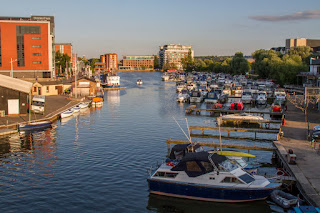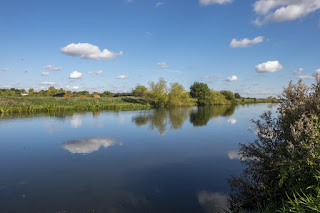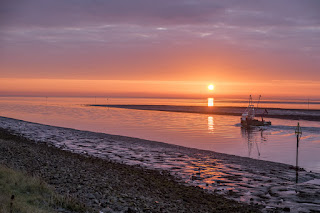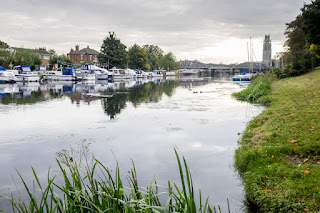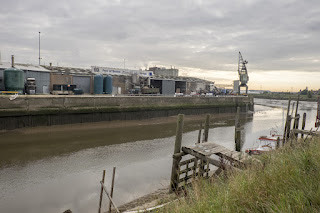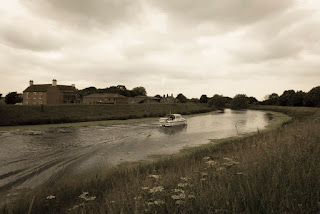Assignment
2: The River
In
producing this assignment I have taken account of the feedback from my tutor on
assignment 1, My reflections on this (Blog Link), presenting
possible work for assignment 2 to a group of level 3 students in the
fortnightly 'hangout', their feedback and my reflections on this (Blog Link and also Blog Link)
Originally
I had planned to base my work around either a local wood or the coast possibly
inspired by the work of Eliot Porter, but my tutor felt that this was too much
within my comfort zone and too scientific.
In view of this I decided to concentrate on the coexistence of nature
and industry, the disused Lincolnshire Loop Railway line, now a cycling and
walking route adjacent to the River Witham and I presented a possible set of
images and contextual background to the Level 3 'Hangout' Group. Feedback from this suggested that the work
was too confused and that there were too many images with no clear
narrative. On reflection I felt that I
was experimenting with too many themes and needed to narrow the work down
considerably.
My
tutor mentioned that the scientific approach to photography uses the camera as
an instrument to observe and measure the universe. He quotes from Lars Von Trier who said 'The universe within yourself is much more
interesting than the one around you.'
In working on this assignment I have been looking within my own universe
at my personal memories and journey through life and have used both the river
and Alfred, Lord Tennyson's poem The
Brook to illustrate that. Although
this is a series of traditional landscapes taken individually, like Alec Soth,
I feel that they should be looked at as a whole to tell a story; that of both
myself and the river. Unlike Soth's images
in Sleeping by the Mississippi, I
feel that mine are sequenced and have a clear narrative.
My
body of work for Assignment 2 is about The River Witham. It rises in the limestone hills of the
Lincoln Edge close to the village of South Witham, flows north and then north
east as a fast flowing, chalk stream to Lincoln, where it enters the Brayford
Pool. This is the end of the navigable part
of the river and, since Roman times was a hive of industry with wharves,
warehouses, mills, breweries and factories, including the nearby vast ironworks
of Clayton and Shuttleworth. The river
leaves The Brayford by passing under the medieval High Bridge, the oldest
bridge in the UK, which still has
buildings on it. (Nicholson pp 63, 68, 2006)
From Lincoln, after flowing through the Lincoln Gap, where it cuts through the soft limestone, it changes direction and flows first east and then
south to Boston, where, after passing through the Great Sluice, it becomes
tidal and flows out to sea into the Wash.
I
grew up on the banks of the Witham; travelled to Lincoln, Boston and Kings
Cross on steam hauled and, later, diesel trains, fished in it, collected train
numbers by it, ran in cross-country races beside it and swam in it. Inspired by the Lincolnshire poet laureate,
Alfred, Lord Tennyson's poem, The Brook,
I see the river as a metaphor for life; mine and the river's. Tennyson's lines
from the poem 'men may come and ,men may
go, but I go on for ever' are a particularly poignant reminder of the
transience of human life, when compared to that of the river as it flows out to
sea to continue its infinite life. The
other lines in the poem speak of the present physical life of the river: its
source, its time as a fast flowing young river, its sedate middle age and,
finally its old age as it enters the sea, eventually to be reincarnated as
another river somewhere else.
Not
only does the river have its own current life, it has been influenced by the
hand of man for over 2000 years. More prehistoric
weapons and tools have been found in the Witham than any other UK river, apart
from the Thames (The Collection, Lincoln). 2500 years ago the river may have
been regarded as a sacred place by the people who lived here. Perhaps the still, marshy pools with their
reflections may have acted as mirrors to the heavens or as portals to the
underworld. These tools and weapons,
many beautifully decorated, were not just thrown away, but deliberately placed
there as offerings to the gods or for the leaders to demonstrate their wealth
(The Collection, Lincoln). Some of these
treasures can be seen in the Collection in Lincoln, including the Fiskerton Log
Boat, but the most famous is the Witham Shield made of iron, inlaid with
bronze, now in the British Museum (although there is a replica in The
Collection).
Following
the iron age came the Romans who used the river for navigation and improved it
from Lincoln to Boston. Trading
continued through the medieval period (Boyes and Russell pp 256-257, 1977) and
canalization and drainage of the adjacent fens began in the 1700s culminating
in the construction of the Great Sluice at Boston, below which it was tidal (Boyes
and Russell p 261, 1977). The railways came in 1848, gradually taking over from
river transport (Boyes and Russell p 266, 1977). The steam packet service
between Lincoln and Boston took a tedious 6 hours, whereas the train took an
hour and twenty minutes. The Stamford
Mercury referred to it as an 'Annihilation of Time and Space' (The Collection). In their turn, though, the demise of the
railways came in the 1960s as a result of the cuts made by Chair of British
Rail, Dr Beeching. Today, although
Boston Docks still serves as a port, commercial traffic has ceased above the
Great Sluice and the only traffic consists of pleasure boats. The disused railway line between Lincoln and
Boston is now used for leisure and forms the Water Rail Way for cycling and
walking and is part of the Viking Way long distance footpath.
This
assignment illustrates the journey of the river from source to sea. I have been
fortunate in life and have had a happy childhood, successful career, marriage
and family and now a contented retirement.
I think that the images in this assignment reflect that, being
picturesque, traditionally composed and largely taken in favourable lighting
conditions.
Whilst
photographing for this assignment I have researched photographers who have,
themselves photographed rivers: Alec Soth's Sleeping
by the Mississippi (2004), Jem Southam's
The Red River(1982-1989) and
Andreas Muller-Pohle's The Danube Project
(2005-2006). I have recorded my
observations about these photographers in my blog under Reading and Research
17. 18 and 19. I find that each of them
has relevance to my work and have found inspiration from them, more especially for how I intend to develop
the project.
In
some ways, the summer has not been the ideal season to start this project as
conditions have meant that it has always been easier to photograph in the
picturesque. That said, I think that,
like many photographers, picturesque photography: favourable lighting with
traditional composition, is ingrained into me, something I intend to address in
later assignments, although for this assignment I feel that the style enhances
the narrative documentary format of the project at this stage, which is what I
wanted to portray. My reading and
research has led to an interest in a comparison of the picturesque, sublime and
topographic, non-aesthetic photography.
I intend to develop this body of work by photographing the river over
the winter and Spring and even choosing to go in inclement weather, looking for
overcast and wintry conditions, especially with fog and mist. I am interested in the prehistoric sacred
history of the river and to that end intend to experiment with long exposure
black and white images and Intentional Camera Movement in order to evoke some
of the mystery of times long past and hidden and also to look for the
reflections that inspired The Celts to make offerings of their weapons. In the same way that Alec Soth and Jem
Southam photographed their rivers without, in some instances, showing it, I
would like to pursue the theme of a sacred river by photographing the abbey
remains and earthworks that abound in the Witham Valley. The other side of the coin is Andreas
Muller-Pohle who actually photographed from within the river, an aspect I am
considering pursuing.
Research
into the work of painters depicting the Witham has also been useful and I have
recorded this in my blog under Reading and Research 20.
The
Brook; Alfred, Lord Tennyson
I come
from haunts of coot and hern,
I make a sudden sally
And sparkle out among the fern,
To bicker down a valley.
By thirty hills I hurry down,
Or slip between the ridges,
By twenty thorpes, a little town,
And half a hundred bridges.
Till last by Philip's farm I flow
To join the brimming river,
For men may come and men may go,
But I go on for ever.
I chatter over stony ways,
In little sharps and trebles,
I bubble into eddying bays,
I babble on the pebbles.
With many a curve my banks I fret
By many a field and fallow,
And many a fairy foreland set
With willow-weed and mallow.
I chatter, chatter, as I flow
To join the brimming river,
For men may come and men may go,
But I go on for ever.
I wind about, and in and out,
With here a blossom sailing,
And here and there a lusty trout,
And here and there a grayling,
And here and there a foamy flake
Upon me, as I travel
With many a silvery waterbreak
Above the golden gravel,
And draw them all along, and flow
To join the brimming river
For men may come and men may go,
But I go on for ever.
I steal by lawns and grassy plots,
I slide by hazel covers;
I move the sweet forget-me-nots
That grow for happy lovers.
I slip, I slide, I gloom, I glance,
Among my skimming swallows;
I make the netted sunbeam dance
Against my sandy shallows.
I murmur under moon and stars
In brambly wildernesses;
I linger by my shingly bars;
I loiter round my cresses;
And out again I curve and flow
To join the brimming river,
For men may come and men may go,
But I go on for ever.
I make a sudden sally
And sparkle out among the fern,
To bicker down a valley.
By thirty hills I hurry down,
Or slip between the ridges,
By twenty thorpes, a little town,
And half a hundred bridges.
Till last by Philip's farm I flow
To join the brimming river,
For men may come and men may go,
But I go on for ever.
I chatter over stony ways,
In little sharps and trebles,
I bubble into eddying bays,
I babble on the pebbles.
With many a curve my banks I fret
By many a field and fallow,
And many a fairy foreland set
With willow-weed and mallow.
I chatter, chatter, as I flow
To join the brimming river,
For men may come and men may go,
But I go on for ever.
I wind about, and in and out,
With here a blossom sailing,
And here and there a lusty trout,
And here and there a grayling,
And here and there a foamy flake
Upon me, as I travel
With many a silvery waterbreak
Above the golden gravel,
And draw them all along, and flow
To join the brimming river
For men may come and men may go,
But I go on for ever.
I steal by lawns and grassy plots,
I slide by hazel covers;
I move the sweet forget-me-nots
That grow for happy lovers.
I slip, I slide, I gloom, I glance,
Among my skimming swallows;
I make the netted sunbeam dance
Against my sandy shallows.
I murmur under moon and stars
In brambly wildernesses;
I linger by my shingly bars;
I loiter round my cresses;
And out again I curve and flow
To join the brimming river,
For men may come and men may go,
But I go on for ever.
References and
Bibliography
Alexander,
J. (2015) Perspectives on Place, London, Bloomsbury
Bate,
D. (2009) Photography, The Key Concepts, London, Bloomsbury
Boyes,
J. & Russell, R. (1977) The Canals of
Eastern England London, David and
Charles
British
Waterways, Lincolnshire County Council and the Environment Agency information
boards
Hunt, N. (2014) Walking the Woods and the Water, London, Nicholas
Brealey Publishing
Leigh
Fermor, P (1977) A Time of Gifts, London, John Murray
Leigh
Fermor, P. (1986) Between the Woods and The Water, London, John Murray
Muller-Pohle,
A. (2005/06) The Danube River Project [online] andreas mullerphole
website. Available from: http://www.muellerpohle.net/projects.html
[Accessed 27.10.15]
Nicholson(2006)
Nicholson Waterways Guide (Vol 6) London,
Harper Collins
Sloth, A. (2004) Sleeping by
the Mississipi [online] Alec Soth website Available from: http://alecsoth.com/photography/?page_id=14
[Accessed 27.10.15]
Southam,
J. (1982-1989) The Red River [online] Landscape Stories website. Available
from:
http://www.landscapestories.net/issue-12/ls_12-001-jem-southam-the-red-river?lang=en
[Accessed 25.10.15]
Tennyson,
A. The Brook
The
Collection, Lincoln
Images
The river rises in the limestone village of South Witham. Often in the summer it is dry.
By the time it reaches North Witham it has become a shallow stream. I come from haunts of coot and hern, I make a sudden sally.
It soon chatters past Colsterworth and
Woolsthorpe, home of Isaac Newton.
I
chatter over stony ways in little sharps and trebles.
At Claypole by thirty hills I hurry down, or slip between the ridges, By twenty thorpes,
a little town, And half a hundred bridges.
I bubble into eddying
bays, I babble on the pebbles
'Till
last by Philips's farm I flow,
At last as the Witham enters Lincoln
it is time to join the brimming river.
In Lincoln the river enters the
Brayford Pool with its famous view of the city's magnificent cathedral.
Once a hive of industry with commercial boats, mills and warehouses, it is now home to leisure craft, restaurants, cinema and university.
As it leaves the Brayford, the river
passes through the Glory Hole and under High Bridge, the oldest bridge in the
UK that still has buildings on it.
Stamp End Lock, one of three on the
navigable section of the river. Here it
says goodbye to the city.
It is near here that Celts over 2000
years ago made offerings of swords, shields and boats, perhaps thinking that
the reflections were a portal to another world. For men may come and men may go, But I go on for ever.
Bardney, the second of the river's
locks to manage river traffic.
Bardney Bridge with sugar beat factory
beyond.
The river from the bridge.
Once a large local employer, Bardney Sugar Beat Factory now stands empty and disused.
Black Horse Bend, in times past a
favourite match fishing venue. Now
anglers prefer commercial ponds. I wind about, and in and out, With here a
blossom sailing, And here and there a lust trout, and here and there a
grayling.
The Witham from the new Kirkstead
Bridge with the disused station of Woodhall Junction and the Water Rail Way to
the left.
My childhood haunt, where I used to
spend much time fishing and swimming. And
here and there a foamy flake, Upon me as I travel, With many a silvery waterbreak,
Above the golden gravel.
Three ways to cross the river: the old
ferryman's cottage, the original bridge, built in 1794 and the modern bridge
behind.
Leisure craft are more likely to be
found on the river now, rather than commercial traffic or anglers. I steal
by lawns and grassy plots, I slide by hazel covers; I move the sweet
forget-me-nots, That grow for happy lovers.
The river reaches Chapel Hill and
approaches Boston and the sea. I slip, I
slide, I gloom, I glance, Among my skimming swallows; I make the netted
sunbeams dance, Against my sandy shallows.
The river and Grand Sluice from the top of 'The Stump'. The Grand Sluice separates the tidal and non-tidal parts of the river. Locks in the sluice still continue to allow boats to pass.
Fishing boats old and new rest on the
mud at low tide in 'The Haven'.
The Port of Boston, still a commercial port, but past its former heyday.
A fishing boat passes down The Haven
at sunrise.
Finally the Witham reaches the end of
its 80 mile journey and flows out into The Wash at sunrise. And out
again I curve and flow, To join the brimming river, For men may come and men
may go, But I go on for ever.........








